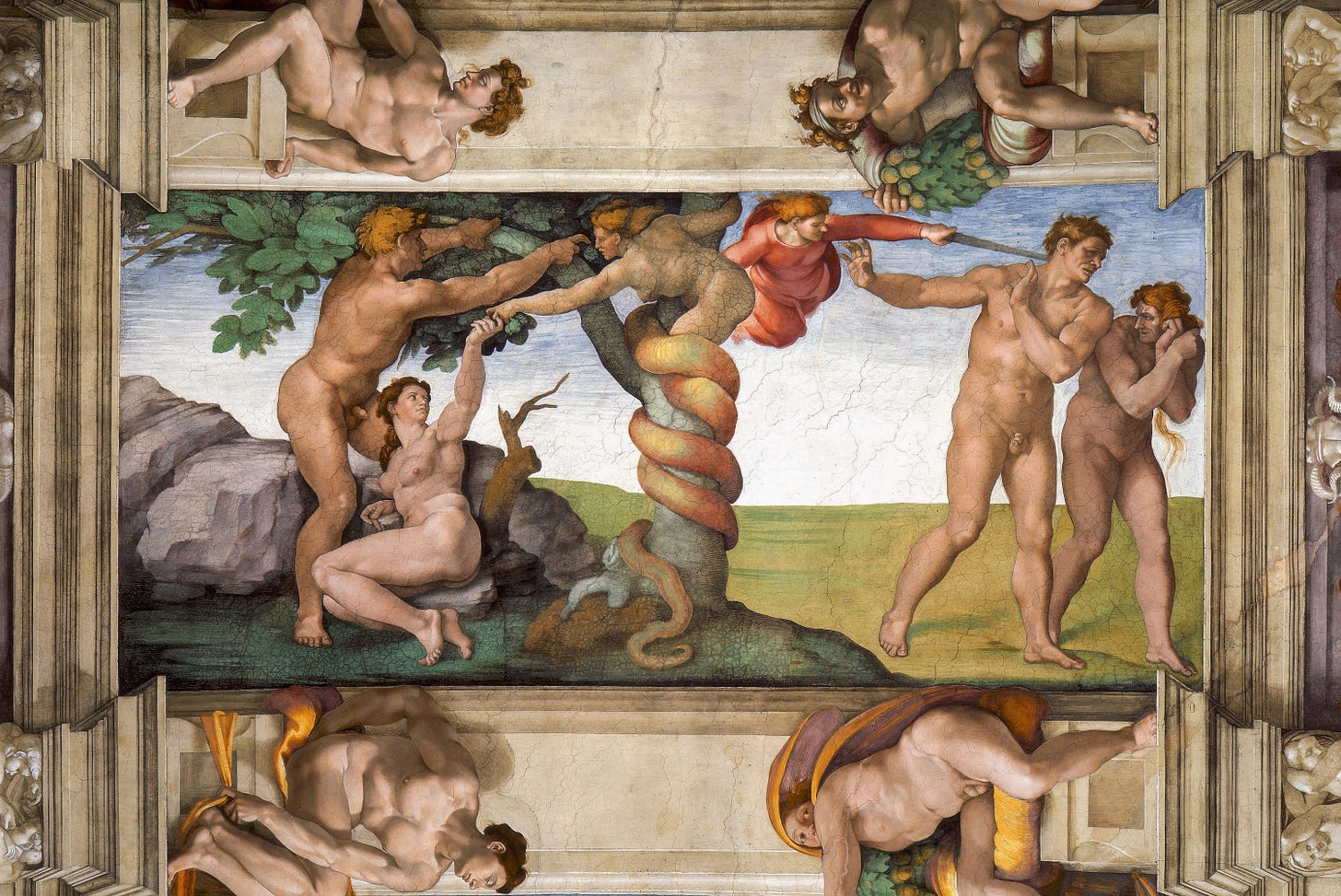There will be time to murder and create,
And time for all the works and days of hands
That lift and drop a question on your plate;
Time for you and time for me,
And time yet for a hundred indecisions,
And for a hundred visions and revisions,
Before the taking of a toast and tea.
In the room the women come and go
Talking of Michelangelo.
-”The Love Song of J. Alfred Prufrock” by T. S. Eliot
Michelangelo Buonarroti is my Roman Empire, the odd fixation that I find myself frequently pondering, in much the same way, apparently, as the red-blooded American male ruminates on Marcus Aurelius. The version of Michelangelo’s story that I return to is not historically accurate; it’s an awkward mutt of a thing, part Irving Stone, part Giorgio Vasari, and part sentimental airbrushing by time and my affection for Ninja Turtles. But over the years, I’ve fallen in love with my version of the story, distorted though it is, because I feel a sort of camaraderie with Mike that has broken my heart and healed my spirit.
Pope Julius II hired Michelangelo to carve his tomb. The plan was magnificent, a massive and imposing Moses, flanked by statues of captive slaves. I think it is the most beautiful thing he ever created, despite the cost. These days, the unfinished slaves are scattered throughout Europe in various museums, hidden treasures waiting to be appreciated by his truest fans. I made a point to seek them out at the Louvre on my first solo trip abroad. I was fresh out of a Modern Lit class with “The Love Song of J. Alfred Prufrock” newly committed to memory, at a time when I was more in love with Michelangelo than ever. These unfinished sculptures were the first thing I’d ever seen that was carved by the man himself -they were the reason I was at the Louvre that day, their deep gouges proof that artist really existed and the things I learned in art history were true. Despite their rough hewn state, they stood in front of me as evidence of the extraordinary plans he once had for the project, the tomb that should have been his magnum opus -until Raphael screwed it all up.
Raphael was a painter, skilled in fresco. He was gregarious and fun; everyone, including the pope himself, enjoyed his company. But he was jealous of Michelangelo’s talent, so Raphael brought an idea to Pope Julius: what if he took over for Michelangelo on the tomb, freeing Mike up to paint the ceilings of his uncle’s chapel? The proposal was nonsense; Michelangelo was riding high on the critical success of his “David,” an irrefutable masterpiece and testament to his genius with stone. Besides, other than a little four-foot portrait of the holy family, Michelangelo didn’t have much experience with fresco. The swap made no sense; Raphael was uninterested in sculpture and anyway, he was busy with other commissions, including a series of his own frescoes in the Vatican. The whole scheme could only end in embarrassment for the both of them, but that was the point. Raphael’s own failure would be quiet -the pope had recently been convinced that building an extravagant tomb while he was still alive was bad form, and so a simpler design would not be disappointing. Michelangelo, however, would fail at fresco dangling sixty feet in the air, trowel and paintbrush in hand.
The provenance of this story has a lot in common with a throwaway line in the song “A Winter’s Ball,” from Hamilton. In it, Burr says of Hamilton, “Martha Washington named her feral tomcat after him!” In the original cast recording of the performance, Lin Manuel Miranda, as the title character, pipes in, “it’s true!” But it’s not. In fact, in Hamilton: A Revolution, Miranda concedes that it’s “most likely a tale spread by John Adams later in life. But I like Hamilton owning it” (70). Although, that’s not true either, strictly speaking. The cat and its name are affirmed in an 1780 letter written by a Captain Smythe (Moore 250). The cat existed, but Miranda took liberties with tone and intent, chiseling and polishing facts to fit his vision. It’s not lying; it’s world-building -the divine right of the storyteller.
The pope kept Michelangelo on the tomb project, and assigned him the ceiling frescoes. Immediately, plans for the tomb had to be revised, pared down to allow time for the ceiling, and construction of the scaffolding that the Sisyphian task would necessitate. It was solitary work that left his vision and posture awkwardly off balance for months, even when he was on solid ground. He hated it. I have to imagine Raphael chuckling at the slapstick agony of it all.
I’ve seen the ceiling twice. My favorite panel is “Expulsion From Paradise” because, like all great storytellers, Michelangelo’s world-building tells a story that is more interesting than true. In this panel, Eve leans back leisurely reaching behind her; Adam has agency. He stands towering above her, grasping the fig tree with both hands, aggressively gesturing at the serpent, whose head and torso are undeniably feminine. He takes the historical prominence from Eve -she’s no longer the agent of change; that role is given to Adam, but in casting the serpent as a woman, her gender is absolved of nothing. I’ve always found this statement to be perplexingly powerful, but ultimately dismissed it as another blow from the patriarchy. However, as time goes by, I am better able to see Michelangelo’s pain and frustration. He had no place in high society Rome at that time. Women were of no interest to him and he lacked the ability to navigate a complex social world. He had to have felt like an outsider, exiled from a society that eagerly devoured his work, but couldn’t make space for the man himself.
Raphael could not have been more different, and perhaps, in Michelangelo’s mind, that difference devolved into animosity. Once, Raphael persuaded Bramante, then working as the papal architect, to sneak him into the chapel to get a look at things. Whether he was there to get a laugh at Michelangelo’s monstrosity of scaffolding and plaster or to sincerely admire the work is irrelevant; he was inspired.
There is no sneaking in slyly to admire the chapel anymore. The line of eager tourists begins forming before dawn, and snakes around the building’s exterior, winding through the once private stanze of Pope Julius. Raphael’s “School of Athens” is a favorite waypoint along the path to the chapel. In it, Raphael thrusts the gloomy likeness of Michelangelo front and almost center.
Some of us recognize that it is Mike, slumped with his head in his hands. Some even know what's got him so down, though I doubt Raphael is among us in that knowledge. Raphael died at thirty-seven when his heart gave out -rumors say he was too enthusiastic in his “socializing” with paid female companions. Whether or not that’s true, he would leave behind a career almost as illustrious as Michelangelo’s. Nor would he have any knowledge of the real cost of the Sistine Chapel’s ceiling: as the project ballooned, expanding onto the back wall and bookending biblical existence with an epic depiction of the last judgment, the tomb languished, dwindling until it was barely a shadow of the original plan.
Taken as a whole, none of it makes sense. All of this subterfuge amounted to nothing. While it is possible to substantiate facts and dates, the scandal itself is difficult to verify in history books. The murmuring docents at St. Peter’s are silent on this piece of centuries old gossip, so tourists wend their way through the labyrinthine Vatican stanze none the wiser -because it didn’t happen. At least not the way I’m telling it.
There is a sentiment widely attributed to Michelangelo, but impossible to authenticate. Sometimes it is cited as coming from Giorgio Vasari: “anyone who sees one of Michelangelo's statues can understand … that the artist's aim was simply to release the figure imprisoned in the stone.” I’ve been unable to find it in his biography of Michelangelo. Other times it reads “I saw the angel in the marble, and carved until I set him free” this version is attributed to Irving Stone’s The Agony and the Ecstasy, but again, I can’t locate that to properly cite either. The thing is, it doesn’t actually matter. The world has already been built. The story is written, silent and waiting to be chipped loose. In my experience as a lifelong procrastinator, this mindset subconsciously absolved me of the guilt that has always come with waiting until the last moment, and allowed me to dodge the spotlight when things turned out predictably brilliant.
The incredible art of the human brain is its propensity to make sense of the world through storytelling. More to the point, we see our own reality reflected back at us over and over as we move through the world. I was twenty-one when I stepped foot in the Louvre. I had transferred to Loyola and moved into a small studio apartment on the north side of Chicago. Despite being absolutely in my element, living in the city, studying at my dream school, a year out from student teaching, I was starting over, lonely and frustrated. The awful stories, tragic explanations for why I, too, felt like an exile, wrote themselves in my head. Or, perhaps, they were already there, waiting to be released.
Looking back on that time from the vantage point of age and formal diagnosis, I now know that I was struggling with debilitating rejection sensitive dysphoria. If a professor’s margin notes on a graded essay were illegible or a friend was late to meet for lunch, my brain filled in the gaps with the most outlandish and painful possibilities. I misconstrued quickly and was loath to concede my error. Reason was irrelevant, and so I did what I felt was my only option: I glamorized my suffering, romanticizing every perceived slight. I’m no Michelangelo, but I think about him often, the way he banished himself unnecessarily from society, much as I had. Did he understand how incredible he was?
I want to tell him that I love the simplicity of his style and brave use of color. The anatomy of his nudes -in painting and stone- is perfectly exaggerated without sacrificing truth; silk draped bodies twist and reach in endlessly diverse postures laying bare the artist’s innate gift. In contrast, the fussiness of Raphael’s work -wispy hair and delicate halos- was a distraction that fooled everyone but me and Mike. But Raphael was cool in a way Michelangelo just couldn’t be. And I can’t escape wondering if that’s what the real conflict was. If, despite his superior talent, he was desperate to feel Raphael’s ease around people. I wonder if he sat on those planks sixty feet up, alone, persuading himself that his misery was entirely Raphael’s fault so that he didn’t have to admit that he was the jealous one.
When you go to Rome, I hope you will make time to visit the Vatican, and see the marvelous ceiling that, despite it all, is the master sculptor’s most well known work. But, I humbly request that you also set aside a few hours to visit San Pietro in Vincoli, the permanent home of Pope Julius II’s tomb. The basilica itself is small and unassuming; the crowds are nonexistent and there is no fee to enter. You can be alone with your truth and Michelangelo’s work. I remember studying various drafts of the tomb in college, each one slightly less grand than the previous, but nevertheless bold and simple, heavy with meticulous attention to anatomy and textile. When I finally arrived at the little church near dusk, I found the entire structure shrouded in scaffolding, save for a small opening through which Moses was only just visible. I was disconsolate. The scaffolding got the better of me, too. Like it had been for Michelangelo, it was yet another obstacle to my joy and satisfaction thrown carelessly in my way by powers so much greater than me.
The basilica of St. Pietro in Vincoli houses the chains that held St. Peter captive in Jerusalem until he was freed by "an angel of the Lord" (Acts 12:7). The pope chose this location for his tomb carefully, just as he chose Moses as the featured subject, but there’s no historical record wherein anyone acknowledges the bitter irony of Michelangelo’s servitude and suffering as he carved a statue of the great liberating prophet to be housed in a basilica alongside the relics of St. Peter’s own deliverance from bondage. But, the human brain is a brilliant storyteller, and I have to think, Mike knew. This is the part of the story I choose to carry with me now: the Archangel Michael was his own Moses, freeing himself from the very chains he created to live a second life in the sewers, hanging out, eating pizza and skateboarding, the chillest of Ninja Turtles. These days, I don’t know any kids still young enough to idolize the heroes in a halfshell; everyone has moved on to newer, cooler things, but I think I’ll hang back just a little longer in the sewers.
References
Miranda, Lin-Manuel, and Jeremy McCarter. Hamilton: The Revolution. Grand Central Publishing, 2016.
Moore, Frank. Diary of the American Revolution, 1860, Vol. 2: From Newspapers and Original Documents (Classic Reprint). FB&C Limited, 2015.
Big thanks to my gem polisher, B-Dub, LU.











Awesome. You might want to check out Gene Openshaw's new book Michelangelo at Midlife: Chasing the Tomb of Julius II. Our friend Moses plays an important role. https://www.goodreads.com/review/show/6473381201
Stop it right now! Ordering it!!!